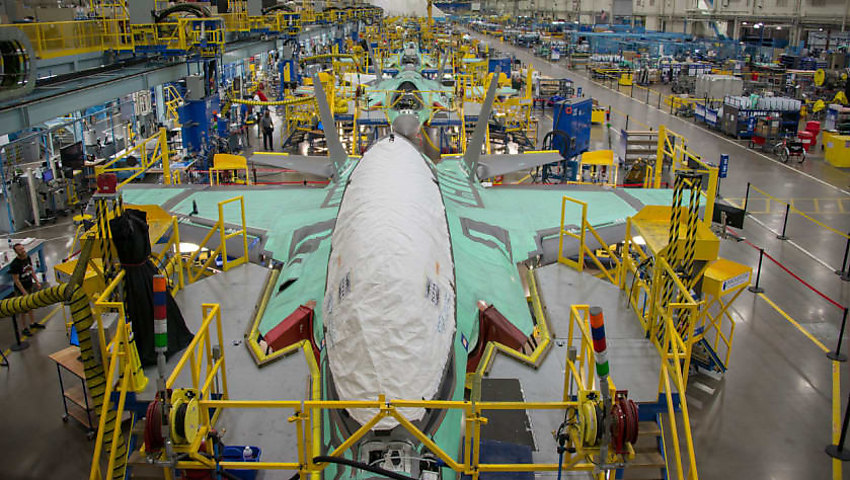Advanced manufacturing, including the internet of things, additive manufacturing and automation, is serving to reshape the industrial capacity of many once great manufacturing nations. For countries like Australia, Industry 4.0 is serving as the opportunity to reindustrialise to support continued growth and competitiveness, while providing opportunities to enhance broader national security.
To continue reading the rest of this article, please log in.
Create free account to get unlimited news articles and more!
As typically innovative industries, both aerospace and defence have moved quickly to adopt the revolutionary technologies of 'Industry 4.0' – the name given to the current trend of automation and data exchange in manufacturing technologies. Industry 4.0 includes cyber-physical systems, the internet of things, cloud computing and cognitive computing, and is commonly referred to as the fourth industrial revolution.
The development of these capabilities has served to reset the industrialisation and manufacturing capacity of nations, which has shifted since the beginning of the first industrial revolution. In doing so, the advent of these technologies and the relative resetting of the global industrial and manufacturing balance of power serves Australia's broader economy and defence industry well.
Australia's period of unprecedented defence investment, which is worth $200 billion and will see the recapitalisation and modernisation of the nation's defence capability supporting the development of a truly sovereign, sustainable and competitive domestic defence industry capability, is uniquely positioned to take advantage of the Industry 4.0 revolution, relatively unencumbered by domestic factors that have long hindered Australia's capacity to be an advanced manufacturing economy.
Recognising this, the Defence Industrial Capability Plan released in 2018 identifies the government's long-term vision to "build and develop a robust, resilient and internationally competitive Australian defence industry base that is better able to help meet defence capability requirements" in recognition of the rapidly evolving geo-strategic environment and Australia's changing role in the region.
The plan acknowledges that as Australia builds its defence capability, we must also grow our defence industrial capability. By 2028, Australia will require a larger, more capable and prepared defence industry that has the resident skills, expertise, technology, intellectual property and infrastructure to:
- Enable the conduct of ADF operations today;
- Support the acquisition, operation and sustainment of future defence capability; and
- Provide the national support base for Defence to meet current needs and to surge if Australia’s strategic circumstances require it.
In two recent articles, Defence Connect has taken a closer look at the role of Australia's defence industry in advancing the future economic and industrial and manufacturing capability of the nation and the necessity for developing a suite of supporting policy mechanisms – Industry 4.0 is now positioned to directly support the sustainable development of Australia's domestic defence industrial base.
Countering areas of weakness
Despite Australia's widely recognised position as providing a world leading research and development capacity – supported by both private and public sector research and development programs driven by organisations like the CSIRO – traditional areas of high wage-costs and low productivity in Australia's manufacturing industry exemplified in the failure of Australia's domestic car industry and in the series of cost overruns and delivery delays on both the Collins and Hobart Class programs have characterised Australia's reputation as a manufacturing economy.
Enter Industry 4.0 – the combination of additive manufacturing, automated manufacturing and data sharing, with a coherent National Strategic Industry development policy can compensate and in some cases overcome the traditional hindrances faced by the Australian economy, with public-private collaboration essential to ensuring the long-term sustainability and success of Australia's defence industrial base and broader manufacturing economy.
While industry largely provides the technological expertise, government policy provides the certainty for investment – particularly when supported by elements of Australia's innovation and science agenda combined with grant allocation and targeted, contractual tax incentives (signed between the Commonwealth and the company as a memorandum of understanding) linked to a combination of long-term, local job creation, foreign contract success, local industry content, and research and development programs, which are critical components that can be used to empower and enhance the overall competitiveness.
Supporting the development of both Australia's defence industrial base and the broader manufacturing economy also requires the legislative power of government to counter-balance industry development policies of allied, yet still competitor nations like South Korea – which leverages the industrial development policies of export oriented industrialisation (EOI) to develop its economy into a major economic and modern, advanced manufacturing powerhouse.
This is done through a range of government-driven incentives for industry, including corporate tax incentives, employment incentives and payroll tax incentives. Australia's now firm commitment to developing a robust domestic defence capability requires innovative and adaptive thinking in order to expand the capabilities and competitiveness of the domestic industry.
Developing and implementing a cohesive, innovative and long-term vision for Australia's sovereign defence industry capability can also serve as the basis for developing and in some cases redeveloping a robust, advanced manufacturing economy taking advantage of Australia's unrivalled resource wealth – supporting the broader national security and interests in the Indo-Pacific.
Let us know your thoughts and ideas supporting the next stages of development for Australia's sovereign defence capability in the comments section below, or get in touch with

 Login
Login







